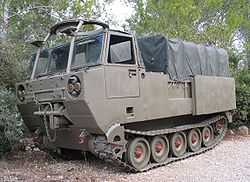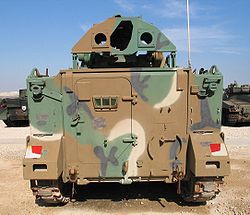Variants of the M113 armored personnel carrier
The following is an extensive catalogue of the variants and specific unique elements of each variant and/or design stage of the M113 armored personnel carrier. For a broader article on the history of the M113, with descriptions of the basic variants, see M113 Armored Personnel Carrier.
Overview
The M113 has become one of the most prolific armored vehicles of the second half of the 20th century, and continues to serve with armies around the world into the 21st century. Not without its faults, the otherwise versatile chassis of the M113 APC has been used to create almost every type of vehicle imaginable. Few vehicles ever created can claim the application to such a wide range of roles from basic utility to ballistic missile transporter-erector-launcher (TEL) to air defense to even a flame throwing vehicle.
Even beyond the myriad of vehicles created by the United States for its own use, scores of variants have been created independantly all over the world. While still bear resemblance to the basic M113, even more share simply the chassis and are in many ways completely new vehicles.
US Variants
- M58- The Wolf Smoke Generator Carrier can produce 90 minutes of visual and 30 minutes of infrared screens.
- M106- Self-propelled Mortar carrier with 107-mm (4.2-inch) mortar firing through large, circular roof hatch in hull rear.
- M125- Mortar carrier similar to M106, but with 81-mm M29 mortar.
- M132- A full-tracked self-propelled flame thrower carrier, with small turret carrying an M108 flamethrower and coaxial M73 machine gun, plus fuel and pressure tanks in rear of hull.
- M163- The Vulcan Air Defense System (VADS) is a M168 anti-aircraft gun mounted on the M741 carrier.
- M474- Carrier used as Pershing 1 nuclear missile Transporter erector launcher (TEL) and as Warhead Carrier, Programmer Test Station/Power Station carrier and Radio Terminal Set carrier.
- M548- Unarmored cargo carrier.

- M577- This variant is used as a command vehicle, generally as a tactical operations center (TOC). The passenger compartment is raised to 74.75 in (189.9 cm). The compartment has a commander's hatch with no weapons mount or vision blocks. A tent is carried on the top rear and attaches directly to the rear of the track to provide greater work space. Multiple M577s can be connected via the tents forming a larger operations center. An additional fuel tank is mounted in the right rear of the compartment. Long-range communications is expedited by the use of a hand-cranked extendible antenna system. A 4.2 kW auxiliary power unit (APU) is mounted on the right front of the vehicle to provide 120 volt power. The APU can be dismounted and sandbagged for noise supression. The compartment includes features such as map boards, folding tables, radio, computer terminals and other command and control equipment.

- M667- MGM-52 Lance missile carrier.

- M727- Unarmored carrier/launcher for the MIM-23 Hawk surface-to-air missiles.

- M730- Unarmored carrier/launcher for the MIM-72 Chaparral surface-to-air missiles.
- M806- Armoured recovery vehicle variant with winch in rear compartment.
- M901- Improved TOW Vehicle (ITV). M113 with twin BGM-71 TOW anti-tank missile launcher mounting on roof.

- M901 - Based on M113A1.
- M901A1 - Based on M113A1.
- M901A2 - Fitted with TOW 2.
- M901A3 - Based on M113A3.
- M981- Fire Support Team Vehicle (FISTV) artillery fire support vehicle. Equipped with sights and other targeting instrumentation in a turret deliberately designed to resemble that of the M901.
- M1015 Tracked Electronic Warfare Carrier -
- M1059 Lynx Smoke Generator Carrier- Smoke generator carrier. Uses the M157 smoke generator set.
- M1064- Mortar carrier, equipped with 120-mm mortar as replacement for M106.
- M1068 Standard Integrated Command Post System Carrier- A modification of the M577 Command Post Carrier.
- M113-1/2 Command and Reconnaissance (Lynx)- Smaller command and reconnaissance vehicle built by FMC using M113A1 components, with four drive wheels on each side and engine in the rear. Lost out in US competition to the M114, but was employed by the Netherlands and Canada (where it was known as the Lynx).

Australian variants
- M113 Fire Support Vehicle (FSV)- Australian variant fitted with turret from Alvis Saladin armoured car.
- M113 Fitter- Armoured recovery vehicle with HIAB (Hydrauliska Industri AB) crane on hull roof.
- M113 Light Reconnaissance Vehicle- A standard M113 with a turret carrying two machine guns; initially used as an armoured personnel carrier. Two versions exist, on using the T50 turret intended for the Cadillac Gage V100/V150 series of armored cars, and another featuring the M74C turret. The main difference is that the T50 mounts two .30 caliber Browning machine guns, while the M74C mounts an M2 .50 caliber machine gun and a .30 caliber Browning gun.
- M113 Medium Reconnaissance Vehicle (MRV)- Australian variant similar to the M113 FSV, but using the turret from the FV101 Scorpion light tank. The MRV also features additional side and frontal armor. The MRV replaced the FSV in Australian service.
Other foreign variants
M113A2 Ultra
Originally M113A1, upgraded to A2 standard and modernised by Singapore with 40mm AGL/.5in HMG or 25 mm Overhead Weapon System Bushmaster guns and improved armour.
